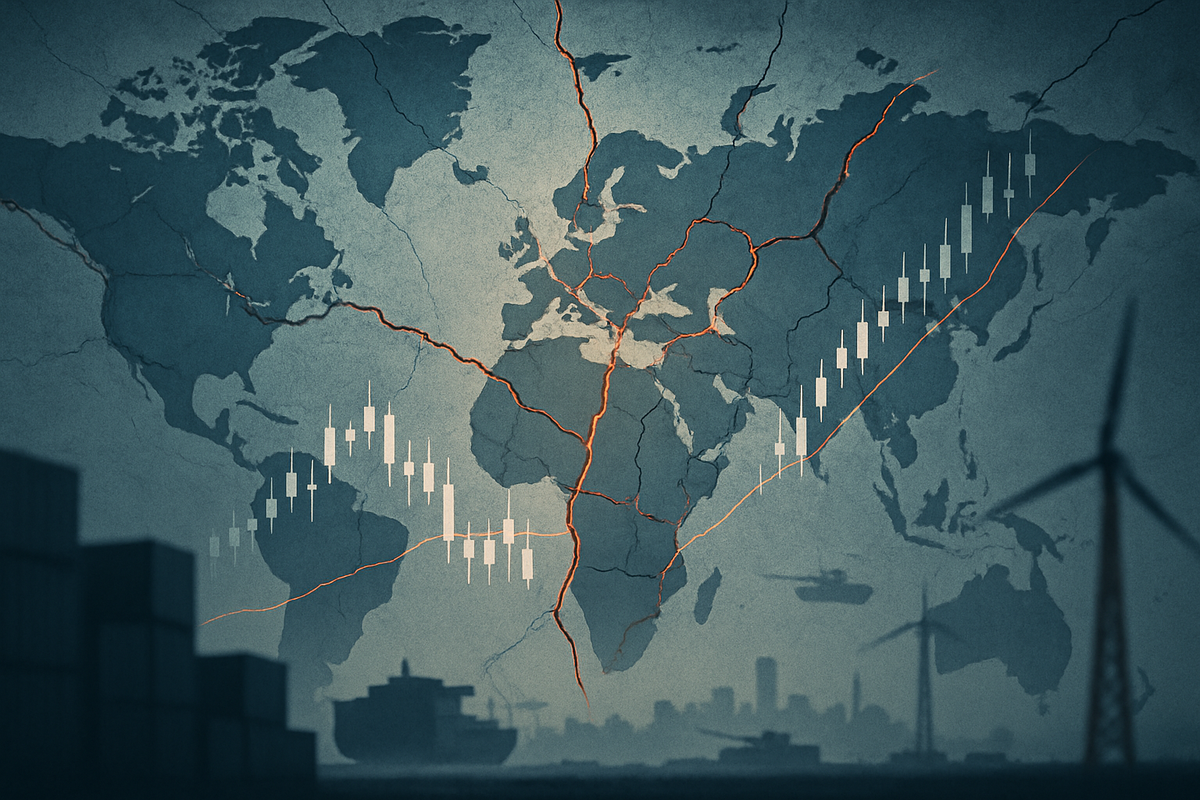
August 27, 2025 – A complex web of elevated global geopolitical risks, spanning from the protracted conflict in Ukraine to persistent tensions in the Middle East and a rising tide of political instability across Europe, is casting a long shadow over the world economy. These multifaceted crises are not merely isolated incidents but interconnected challenges actively disrupting international trade, stifling investment flows, and severely straining global supply chains, pushing the global financial system into an era of heightened uncertainty and unprecedented volatility. The immediate implications are already being felt, with significant pressure on commodity prices, increased inflationary trends, and a palpable shift in investor sentiment away from riskier assets.
A Perfect Storm: Conflicts, Instability, and Their Economic Fallout
The current geopolitical landscape is defined by a confluence of disruptive events, each carrying profound economic implications. The ongoing military engagements and political fractures are not just regional concerns; they are systematically eroding the foundations of global economic stability and testing the resilience of interconnected markets.
The conflict in Ukraine, now a prolonged struggle, continues to be a major catalyst for global economic fragmentation. Both Ukraine and Russia are pivotal suppliers of critical commodities, including wheat, oil, and natural gas. The war has engineered massive disruptions to these supply lines, leading to a dramatic surge in global prices, further fueling inflationary pressures that had already begun to take hold. Europe, particularly, has grappled with the severe consequences of weaning itself off Russian energy, experiencing substantially higher energy costs that have severely impacted its manufacturing competitiveness. Beyond the immediate economic indicators, the conflict has resulted in an immense loss of human capital and widespread infrastructural devastation within Ukraine. The imposition of sweeping sanctions against Russia has not only deepened this economic fragmentation but also forced a re-evaluation of long-term trade relationships and investment strategies worldwide. Financial markets reacted sharply in the initial phases, with the Russian ruble plummeting, and global equity markets, especially in Europe, experiencing significant declines.
Simultaneously, tensions in the Middle East remain a significant threat to global economic stability, primarily due to the region's critical role as an energy hub and a nexus for vital trade routes. Any escalation in conflict here carries the potential to trigger a dramatic surge in oil prices, with severe scenarios projecting a doubling to $150 per barrel, unleashing a new wave of global inflation and exacerbating existing supply chain issues. Recent attacks on commercial ships in crucial waterways, such as the Red Sea, have already demonstrated this fragility, leading to increased shipping costs and substantial delays in global trade. The resulting uncertainty has driven investors towards traditional safe havens like gold and US Treasuries, away from more volatile assets. The local economic repercussions are devastating, marked by severe contractions, job losses, and long-term negative impacts on productivity and development in the affected areas. Neighboring oil-importing countries in the MENA region have also observed declines in economic growth and widening current-account deficits.
Adding another layer of complexity is the pervasive political instability in Europe. This includes a series of government crises, rising populist movements, and growing nationalist sentiments across the continent, which collectively contribute to heightened market uncertainty and exert downward pressure on the Euro. Recent political turmoil in France, for instance, sparked by looming no-confidence votes over budget cuts, sent shockwaves through European markets, causing declines in major indices and raising concerns about sovereign credit ratings. Germany, the continent's economic powerhouse, has also faced its share of upheaval, including a recent government collapse that compounded existing economic challenges, with the European Commission projecting a contraction in Germany's economy for 2024 amidst high uncertainty impacting consumer spending and business investment. Such instability hinders governments' ability to implement necessary reforms, maintain consistent economic policies, and ultimately leads to increased borrowing costs for nations and a significant erosion of consumer and business confidence. Given the deeply interconnected nature of European economies, political uncertainty in one major country can swiftly cascade, affecting neighboring countries and key trading partners. These events underscore a challenging period where geopolitical forces are reshaping economic realities with unprecedented speed and impact.
Winners and Losers in a Fragmented World
The escalating global geopolitical risks are creating a stark divide in the corporate world, producing clear winners and a much broader spectrum of losers. Companies with robust governmental ties, strategic resource access, or those offering essential security solutions are poised to thrive, while those reliant on frictionless global trade and stable international relations face significant headwinds.
The most undeniable beneficiaries are companies within the Defense and Aerospace Industry. Heightened global tensions, particularly the ongoing war in Ukraine and the persistent instability in the Middle East, have triggered a substantial increase in defense spending across NATO members and other nations. Governments are committing billions to modernize their militaries and replenish arsenals, leading to a surge in orders for weapons, military equipment, and related services. European defense spending is projected to reach 3.1% of GDP by 2029, illustrating the long-term commitment. Key players benefiting include German defense contractor Rheinmetall (RHM.DE), whose shares have more than doubled since early 2025 due to strong positions in munitions and land vehicles. U.S. giants such as Lockheed Martin (LMT), securing multi-billion-dollar contracts for missile programs, and RTX (Raytheon) (RTX), benefiting from increased demand for its AMRAAM missiles, are also seeing significant gains. British multinational BAE Systems (BA.) and Swedish defense company SAAB (SAAB B), with its expertise in electronic warfare, are likewise experiencing substantial share appreciation.
Beyond traditional defense, the increased threat landscape also provides opportunities for Cybersecurity firms. As state-sponsored cyberattacks become more frequent and sophisticated, governments and corporations are compelled to invest heavily in protecting critical infrastructure and sensitive data. While specific pure-play cybersecurity companies were not highlighted as direct "winners" in the research, the underlying trend points to a growing market for robust cyber defense solutions. Similarly, companies offering AI-driven Logistics and supply chain management tools are emerging as crucial enablers for businesses striving to navigate increasingly disrupted and complex global supply chains. Furthermore, certain Commodity Producers from politically stable jurisdictions, particularly those dealing in critical minerals, can command premiums as global supply chains fragment. Precious metals, especially gold, traditionally serve as a safe haven during times of uncertainty and inflation, leading to increased investor interest in gold producers like Barrick Gold (GOLD) and Newmont (NEM).
On the flip side, a wide array of industries and companies are facing significant challenges. The Logistics and Shipping Industry, while initially appearing to benefit from longer routes, is ultimately burdened by increased operational costs. Rerouting vessels, such as around the Cape of Good Hope to avoid the Red Sea, substantially increases transit times, fuel consumption, and insurance premiums, eroding profitability for carriers like Euronav (EURN), Maersk (MAERSK-B.CO), and Hapag-Lloyd (HLAG.DE). These costs are often passed on, contributing to global inflation.
The Consumer Goods and Retail sector is particularly vulnerable due to its heavy reliance on global supply chains and sensitive consumer sentiment. Disruptions, increased shipping costs, and tariffs translate into higher input prices, forcing companies to either absorb costs or pass them to consumers, impacting both profitability and sales. Geopolitical events can also trigger shifts in consumer attitudes, leading to boycotts; for example, Starbucks (SBUX) has faced boycotts in the Middle East and the U.S. Companies like Apple (AAPL), with extensive manufacturing operations in geopolitically sensitive regions such as China, face the risk of surging production costs due to potential tariffs and further supply chain fragmentation. The broader Technology Sector, beyond cybersecurity, is struggling with "tech decoupling" and export restrictions on critical components like semiconductors, leading to higher production costs, reduced access to key inputs, and stifled innovation.
Other affected sectors include Tourism and Hospitality, which is highly sensitive to perceptions of instability, leading to reduced travel and rising insurance costs, particularly in or near conflict zones. Financial Services firms are exposed to increased market volatility, operational risks from cyber-attacks and sanctions compliance, and heightened credit risks. Lastly, Infrastructure and Construction companies operating in politically volatile regions face risks of project interruptions, non-payment, and even asset confiscation due to shifts in government policy or civil unrest. In this volatile environment, companies with diversified operations, robust risk management strategies, and adaptable supply chains are best positioned to weather the storm.
Industry Shifts and Broader Implications: A Reshaping of Global Commerce
The confluence of elevated global geopolitical risks is not merely causing temporary market fluctuations; it is fundamentally reshaping long-term industry trends, forcing a re-evaluation of business models, and catalyzing significant shifts in global economic policy. The era of seamless globalization appears to be waning, replaced by a more fragmented, regionalized, and risk-averse commercial landscape.
One of the most profound shifts is the acceleration of deglobalization and regionalization. Events like the Ukraine war, coupled with prior shocks such as the COVID-19 pandemic and lingering US-China trade tensions, have starkly exposed the vulnerabilities inherent in highly interconnected global supply chains. This has fueled a surge in protectionist policies and a strategic pivot towards securing national and regional economic interests. Companies are increasingly adopting strategies such as reshoring (bringing production back home), nearshoring (establishing supply chains with neighboring countries), and friendshoring (relying on allies). While these approaches may lead to higher costs and reduced supplier diversity in the short term, the long-term goal is to bolster national security, enhance economic stability, and reduce dependencies on volatile regions. This push for regional economic blocs and integrated supply networks is a direct consequence of the perceived instability of globalized production.
The imperative for supply chain resilience has become paramount. Geopolitical disruptions, whether through physical conflicts, trade restrictions, or cyberattacks, have highlighted the critical need for businesses to build more robust and adaptable supply chains. The Houthi attacks in the Red Sea, for example, forced massive rerouting of shipping around the Cape of Good Hope, significantly increasing transit times and costs. In response, companies are actively diversifying their supply sources, investing heavily in advanced analytics and AI for real-time visibility, building strategic inventory buffers, and strengthening collaborative relationships with key suppliers. The goal is to move from lean, cost-optimized supply chains to agile, resilient networks capable of quickly adapting to unforeseen disruptions.
The energy transition is also profoundly impacted. While geopolitical events can introduce challenges, such as disruptions to the supply chains for critical minerals essential for renewable technologies, they often act as powerful catalysts. The Russia-Ukraine conflict, in particular, underscored Europe's dangerous reliance on Russian natural gas, prompting a swift and aggressive pivot towards energy independence. This has accelerated investment in diversified energy sources, including Liquefied Natural Gas (LNG), wind, and solar power, and fostered a greater focus on localized power solutions. The heightened risk of cyberattacks on energy infrastructure further emphasizes the need for robust cybersecurity within the energy sector.
The ripple effects extend across diverse sectors. In commodity markets, disruptions from Ukraine (wheat, sunflower oil, corn, industrial metals, neon) and the Middle East (oil and gas) have led to increased prices, shortages, and higher input costs for industries globally. The global competition for LNG has intensified, benefiting exporters like Cheniere Energy, Inc. (LNG). In logistics, freight costs have soared, and critical China-Europe rail routes traversing Russia have been stalled, necessitating costly rerouting and impacting international trade. Regulatory and policy implications are equally significant. Governments are increasingly implementing protectionist measures (tariffs, export restrictions) and industrial policies (e.g., the US CHIPS and Science Act, European Chips Act) to safeguard strategic industries like semiconductor manufacturing. Trade regulations and sanctions are in a constant state of flux, creating unpredictability, while financial regulators demand tighter controls to prevent money laundering and sanctions evasion.
Historically, this period shares striking parallels with past eras of upheaval. The current trend of deglobalization is often compared to the 1930s, following World War I and the Great Depression, which saw a collapse of world trade, rampant protectionism (e.g., the Smoot-Hawley Tariff Act), and a retreat into national economies. The energy crises exacerbated by current conflicts echo the 1970s oil crises, triggered by Middle Eastern geopolitical tensions, which led to severe petroleum shortages, skyrocketing prices, and a global push for energy diversification. While historical geopolitical events have sometimes had transient impacts on broad equity markets, the sheer confluence and persistence of current risks may pose a more sustained challenge to global economic stability, forcing a more fundamental restructuring of global commerce than previously seen.
What Comes Next: Navigating a New Geopolitical Landscape
The path forward for the global economy and financial markets is fraught with both challenges and the potential for strategic adaptation. In the short term, continued volatility appears inevitable as geopolitical tensions remain elevated. Companies and nations must brace for sustained disruptions to trade, persistent inflationary pressures, and unpredictable shifts in market sentiment. The immediate future will likely see further reconfigurations of supply chains, with an increasing emphasis on regional hubs and trusted alliances over purely cost-driven global networks. Businesses that have already invested in flexible and diversified logistics will be better positioned to weather the ongoing storm.
In the long term, the current geopolitical climate is likely to accelerate a more fundamental restructuring of the global economic order. We can anticipate an enduring shift towards greater self-reliance and strategic autonomy in critical sectors, especially energy, technology, and essential commodities. This will drive significant investment in domestic production and innovation, potentially creating new regional economic powerhouses. Governments will increasingly utilize industrial policies and trade agreements to bolster national interests and resilience, leading to a more complex and potentially less efficient international trading system. For companies, this means a necessity for strategic pivots towards localized operations, enhanced risk management frameworks, and a keen understanding of evolving regulatory landscapes. Market opportunities may emerge for businesses that can provide solutions for supply chain resilience, cybersecurity, domestic manufacturing, and diversified energy technologies. Conversely, those overly reliant on singular global supply lines or exposed to highly volatile regions face an existential challenge. Investors should prepare for continued market segmentation, where geopolitical factors become as critical as traditional economic indicators in assessing asset performance.
Conclusion: A New Era of Risk and Resilience
The current era, characterized by elevated global geopolitical risks stemming from conflicts in Ukraine and the Middle East, alongside pervasive political instability in Europe, represents a pivotal moment for the global economy. These interlocking crises are not merely transient disturbances but powerful catalysts for profound structural changes, compelling businesses and governments to fundamentally rethink global trade, investment, and supply chain strategies. The prevailing narrative of seamless globalization is yielding to one of strategic regionalization, enhanced resilience, and a renewed focus on national and allied economic security.
The key takeaway is that geopolitical risk is no longer a peripheral concern but a central driver of market dynamics. Companies that previously thrived on lean, globally optimized supply chains are now scrambling to diversify, nearshore, or reshore operations, accepting higher costs in exchange for greater stability. The defense industry and providers of cybersecurity and advanced logistics solutions are emerging as clear beneficiaries of this heightened uncertainty. Conversely, industries heavily dependent on global trade, such as certain segments of consumer goods, technology, and shipping, face ongoing headwinds from increased costs, disruptions, and shifting consumer sentiment.
Moving forward, investors should keenly watch for several critical indicators. The trajectory of ongoing conflicts, particularly in Ukraine and the Middle East, will continue to dictate energy prices and commodity availability. The stability of European political landscapes will influence investor confidence and the pace of regional economic integration. Furthermore, observe how governments implement new industrial policies and trade agreements, as these will shape the competitive landscape for years to come. Companies demonstrating agility, investing in resilient supply chains, and adapting to a more fragmented global order will be better positioned to navigate this turbulent environment. The market of the coming months will reward foresight, adaptability, and a robust understanding of the intricate interplay between geopolitics and global economics.






